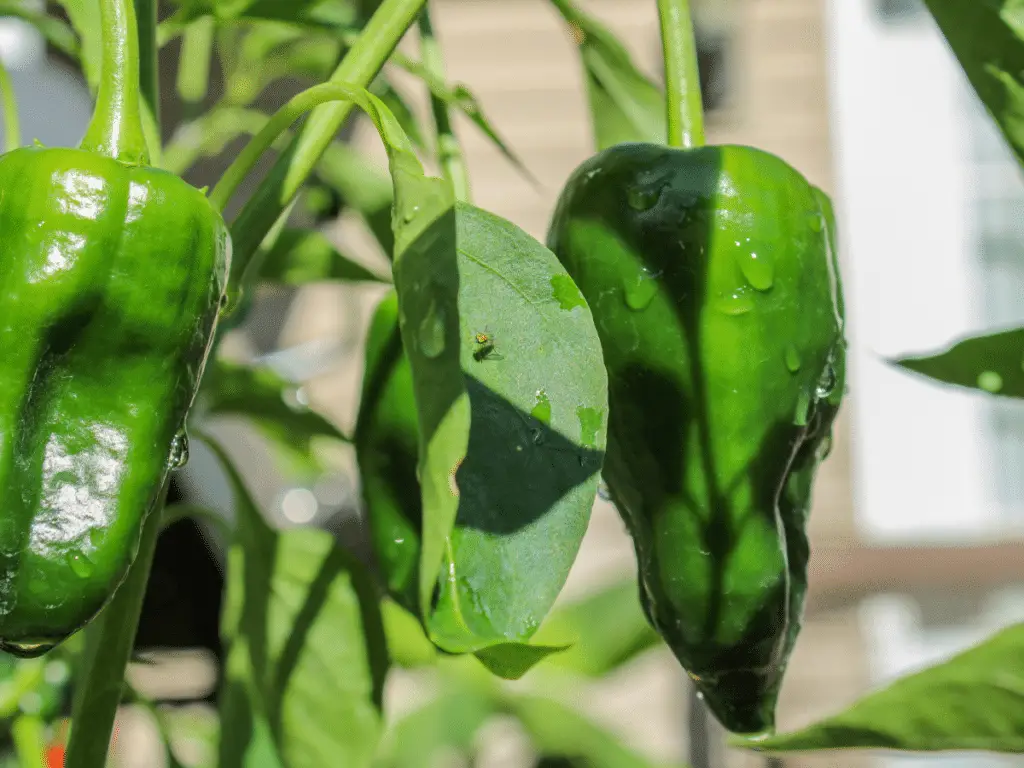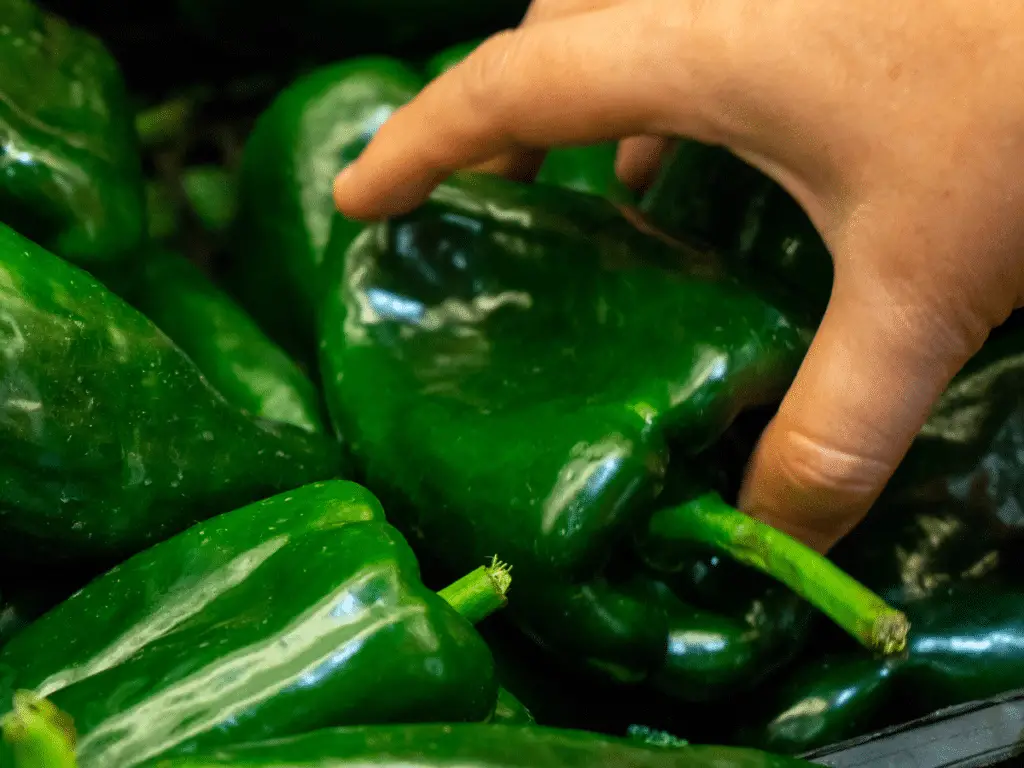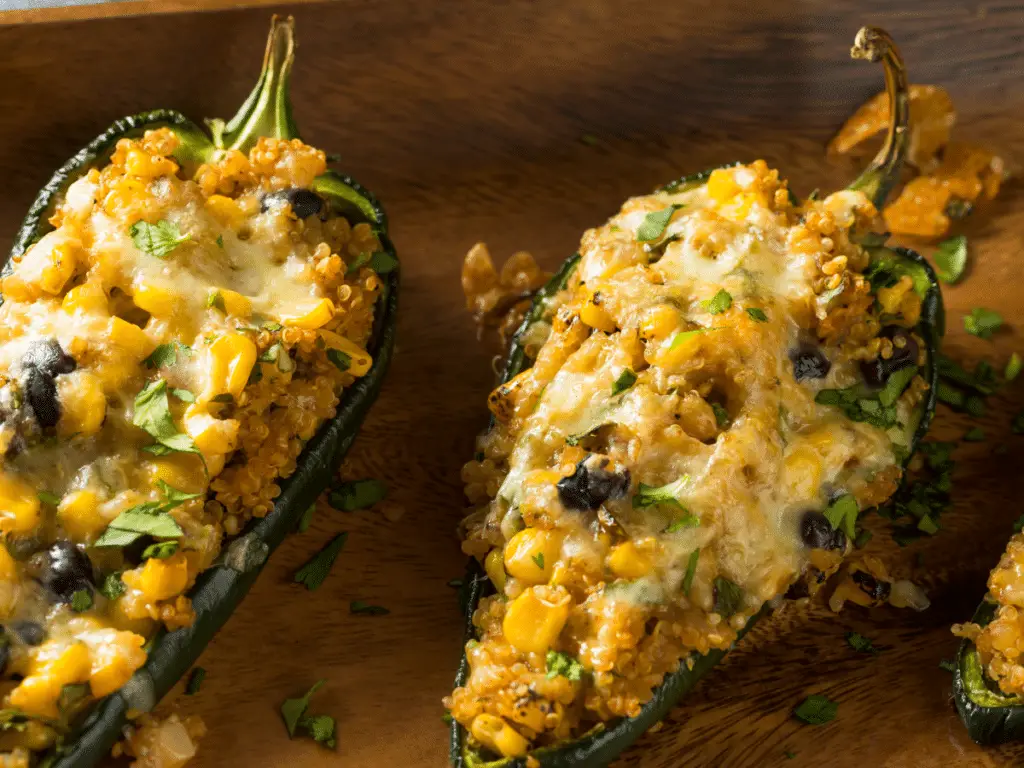Fruits and vegetables always taste better when they’re in season, and peppers are no exception. So when are poblano peppers in season?
Poblano peppers are in season when your growing area experiences temperatures between 70 and 85°F during the day and above 50°F. This will vary depending on which USDA Hardiness Zone you reside in. Planting them in season will yield a larger harvest and a better quality pepper. Purchasing poblanos in season means they will be fresher in the store.
Read on to learn more about buying poblanos in season!
What are poblano peppers?
Let’s start with the basics.
Poblano peppers are mildly spicy peppers with a rating of 1,000-2,000 SHU. They have a rich, smoky flavor. Poblanos mature from green to red and get spicier as they grow, but they can be cooked and eaten at any stage of the growing process.

Poblano peppers are slightly spicy peppers with a Scoville Heat Unit rating of 1,000-2,000.
They have a deep, rich umami flavor. Poblano peppers look like flattened bell peppers and can range from 4-6 inches long.
Poblano peppers can be harvested and eaten when immature or mature. Immature poblanos are still green, shorter, and milder. As poblanos age, they grow to a deep red and can double in spiciness.
Poblano peppers are from Puebla, Mexico, and are used in traditional Mexican cooking. You can also use them as a more flavorful substitute for bell peppers.
Does it matter if peppers are in season?
What’s the big deal about seasonality?
Peppers taste much better when they’re in season. They aren’t in storage for as long as they can be picked closer to the time of sale or don’t need to be transported from an area where they are in season. By the same token, fresher peppers go bad more quickly – so take that into account!
Think about how much more delicious apples and pears are in the fall. You can eat them all year round, but you’ll definitely taste the difference when they’re in season.
The same goes for peppers. You can eat and cook with peppers any time of year. But off-season peppers have been in storage for, well, a year! They’re picked early and stored in warehouses until they get shipped out to stores.
Meanwhile, peppers in-season have a quicker turnaround and aren’t picked as young. They’re fresher and more flavorful. They’re also much easier to find.
Poblano pepper seasonality
On a related note, when are poblano peppers in season?
Poblano pepper seasonality depends on where you live. Poblanos can be in season in the winter if you live in a warm climate, whereas they’re summer vegetables in colder climates.
Poblano peppers can be grown in many different USDA Hardiness Zones.
Some hardiness zones, such as 9b, have two growing seasons – one in the fall and one in the spring. Instead of worrying about frost, these growers worry about summer heat!
On the other hand, growers in colder zones are always trying to beat the winter.
Considering these two facts, poblanos can be in season at different times of the year depending on your hardiness zone. They can be fully ripe during the winter in warmer zones, and meanwhile not even ready to plant yet in colder zones!
Wondering about the best time to plant poblanos for your garden? Check out this article for your USDA growing zone!
Buying and storing poblano peppers
How do you pick and store poblanos?
Buy poblano peppers based on how spicy you want them to be. A red color will indicate that your poblanos are more mature – therefore spicier – than green ones. The best way to store poblano peppers is to put them in the crisper drawer of your fridge, although that will greatly slow down ripening.
When buying poblano peppers, perhaps the most important factor is color.

Green poblanos are technically still immature and won’t be as spicy as deep red poblanos. However, red poblanos will spoil more quickly because they’re more mature.
You can always buy green ones and wait for them to ripen, but depending on when they were picked, they might not reach the level of ripeness you’re looking for.
It’s also important for your poblanos to be firm when you buy them. Otherwise, they’re already spoiling.
Moving onto storage, there are plenty of ways to store peppers.
The first thing to note is that storing your poblanos in the fridge will slow down the ripening process. So if you’re trying to ripen them off the vine, your best bet is leaving them on the counter even if it means they won’t last as long.
Your poblanos will make it a week on the countertop, but closer to two weeks in the fridge. They also stay crisper when refrigerated.
It’s best to put them in the crisper drawer, and you can use a cloth bag to keep them organized.
If you only need half a poblano for a recipe, store the rest in a sealed container with the stems and seeds still attached. This will trick your pepper into thinking it’s still “alive” and stay fresher for longer!
Cooking with poblano peppers
Now that you know about seasonality, how to pick poblanos, and how to store them – let’s talk about how to cook with them!
Some great ways to cook with poblano peppers include blistering, stuffing, frying, and drying them.
Blistering poblano peppers is one of the best ways to bring out their deep, smoky flavors. Blistering is the act of charing poblanos by leaving them alone over high heat.

People also like to stuff poblanos. They’re perfect for stuffing because they’re big and sturdy.
You can fry your peppers using multiple methods. An air fryer, a pan, or a deep fryer all work well.
Drying poblanos will turn them into ancho chile peppers, which are popular in Mexican cuisine.
Conclusion
In all, poblano peppers taste much better when they are in season! You can buy them during different seasons depending on where you live.
Pick out poblano peppers that are firm, and take into consideration how spicy you want them to be.
Lastly, be sure to give some of our recipes a shot!

